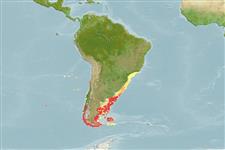Ikan bertulang rawan (sharks and rays) >
Carcharhiniformes (Ground sharks) >
Atelomycteridae (Coloured catsharks)
Etymology: Schroederichthys: In honor of American ichthyologist William C. Schroeder (1895-1977), Woods Hole Oceanographic Institution, for his pioneering work (with Henry B. Bigelow) on cartilaginous fishes; ichthyos (Gr.), fish. (See ETYFish); bivius: bi-, from bis (L.), two; via (L.), way or passage, etymology not explained, perhaps referring to double-valved nostrils, with incurrent and excurrent apertures. (See ETYFish).
More on authors: Müller & Henle.
Environment: milieu / climate zone / depth range / distribution range
Ekologi
laut dasar (demersal); kisaran kedalaman 14 - 78 m (Ref. 244). Subtropical; 23°S - 56°S
Southeast Pacific and Southwest Atlantic: central Chile to the Straits of Magellan and Argentina.
Length at first maturity / Size / Weight / umur
Maturity: Lm ?, range 40 - ? cm
Max length : 70.0 cm TL jantan/; (Ref. 244)
A common inshore to offshore shark found on the continental shelf. Oviparous (Ref. 50449). Dental sexual dimorphism exists, with adult males having teeth at least twice as high as adult females as well as much longer and narrower mouths.
Oviparous, paired eggs are laid. Embryos feed solely on yolk (Ref. 50449). Sexual dimorphism is evident in dentition of male species (Ref. 49562). Males have longer teeth with fewer cusps than females (Ref. 51093) to make 'courtship biting' more effective (Ref. 49562).
Compagno, L.J.V., 1984. FAO Species Catalogue. Vol. 4. Sharks of the world. An annotated and illustrated catalogue of shark species known to date. Part 2 - Carcharhiniformes. FAO Fish. Synop. 125(4/2):251-655. Rome: FAO. (Ref. 244)
Status IUCN Red List (Ref. 130435)
ancaman kepada manusia
Harmless
penggunaan manusia
Perikanan: tidak ada kepentingan
informasi lanjut
Umur / SaizPertumbuhanpanjang-beratpanjang-panjangukuran frekuensiMorfometrikMorfologiLarvaDinamika larvapemulihanKelimpahanBRUVS
mitraGambarStamps, Coins Misc.Suara-suaraCiguateraKecepatanTipe renangArea insangOtolithsOtakPenglihatan / visi
Alat, peralatan
laporan khas
muat turun XML
Sumber internet
Estimates based on models
Preferred temperature (Ref.
123201): 6.4 - 15.6, mean 10.6 °C (based on 202 cells).
Phylogenetic diversity index (Ref.
82804): PD
50 = 0.5312 [Uniqueness, from 0.5 = low to 2.0 = high].
Trophic level (Ref.
69278): 3.8 ±0.3 se; based on diet studies.
Daya lenting (Ref.
120179): sangat rendah, Waktu penggandaan populasi minimum lebih dari 14 tahun (Fec=2).
Fishing Vulnerability (Ref.
59153): Moderate to high vulnerability (48 of 100).
Nutrients (Ref.
124155): Calcium = 27.1 [4.5, 147.7] mg/100g; Iron = 0.723 [0.192, 2.131] mg/100g; Protein = 16.1 [13.3, 20.4] %; Omega3 = 0.18 [0.08, 0.39] g/100g; Selenium = 19.3 [5.8, 54.7] μg/100g; VitaminA = 10.6 [3.7, 29.9] μg/100g; Zinc = 0.636 [0.303, 1.164] mg/100g (wet weight); based on
nutrient studies.
